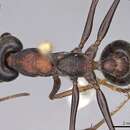ar
الأسماء في صفحات التنقل


Taxonomic history
Senior synonym of Myrmecia crassinoda: Brown, 1953j PDF: 27; Ogata & Taylor, 1991 PDF: 1629.Senior synonym of Myrmecia fallax: Brown, 1953j PDF: 27; Ogata & Taylor, 1991 PDF: 1629.Senior synonym of Myrmecia murina: Brown, 1953j PDF: 27; Ogata & Taylor, 1991 PDF: 1629.
Myrmecia pulchra is an Australian bull ant species, a part of the genus Myrmecia. They are native to Australia. They are heavily distributed in Victoria, Australian Capital Territory, and New South Wales, notably around the coastlines.[2]
The appearance of Myrmecia pulchra is that nearly the entire body is in a slightly light brown colour. The only exceptions is that the mandibles are slightly lighter and the thorax is completely black.[3][4]
Myrmecia pulchra is an Australian bull ant species, a part of the genus Myrmecia. They are native to Australia. They are heavily distributed in Victoria, Australian Capital Territory, and New South Wales, notably around the coastlines.
The appearance of Myrmecia pulchra is that nearly the entire body is in a slightly light brown colour. The only exceptions is that the mandibles are slightly lighter and the thorax is completely black.
Myrmecia pulchra is een mierensoort uit de onderfamilie van de Myrmeciinae.[1][2] De wetenschappelijke naam van de soort is voor het eerst geldig gepubliceerd in 1929 door Clark.
Bronnen, noten en/of referentiesMyrmecia pulchra Clark, 1929
СинонимыMyrmecia pulchra (лат.) — вид примитивных муравьёв Австралии из рода Myrmecia.
Юго-восточная и южная Австралия[1][2].
Длина рабочих 15—20 мм, самки 20—22 мм. Двухцветные: голова и брюшко чёрные, остальные части тела (грудь, стебелёк, ноги, усики, мандибулы) — коричневые. Жвалы длинные многозубчатые. Глаза большие выпуклые, расположены в передней части головы рядом с основанием мандибул. Оцеллии развиты. Нижнечелюстные щупики 6-члениковые, нижнегубные щупики состоят из 4 сегментов. Стебелёк двучлениковый, состоит из петиоля и постпетиоля. Скапус усиков самцов короткий. Крылья с одной маргинальной, тремя субмаргинальными и двумя дискоидальными ячейками. Жало развито. Куколки крытые, в коконе. Вид был впервые описан в 1929 году австралийским мирмекологом Джоном Кларком (John S. Clark, 1885—1956), Национальный музей Мельбурна)[1][2][3][4]. Включён в состав видовой группы Myrmecia gulosa species group[5].